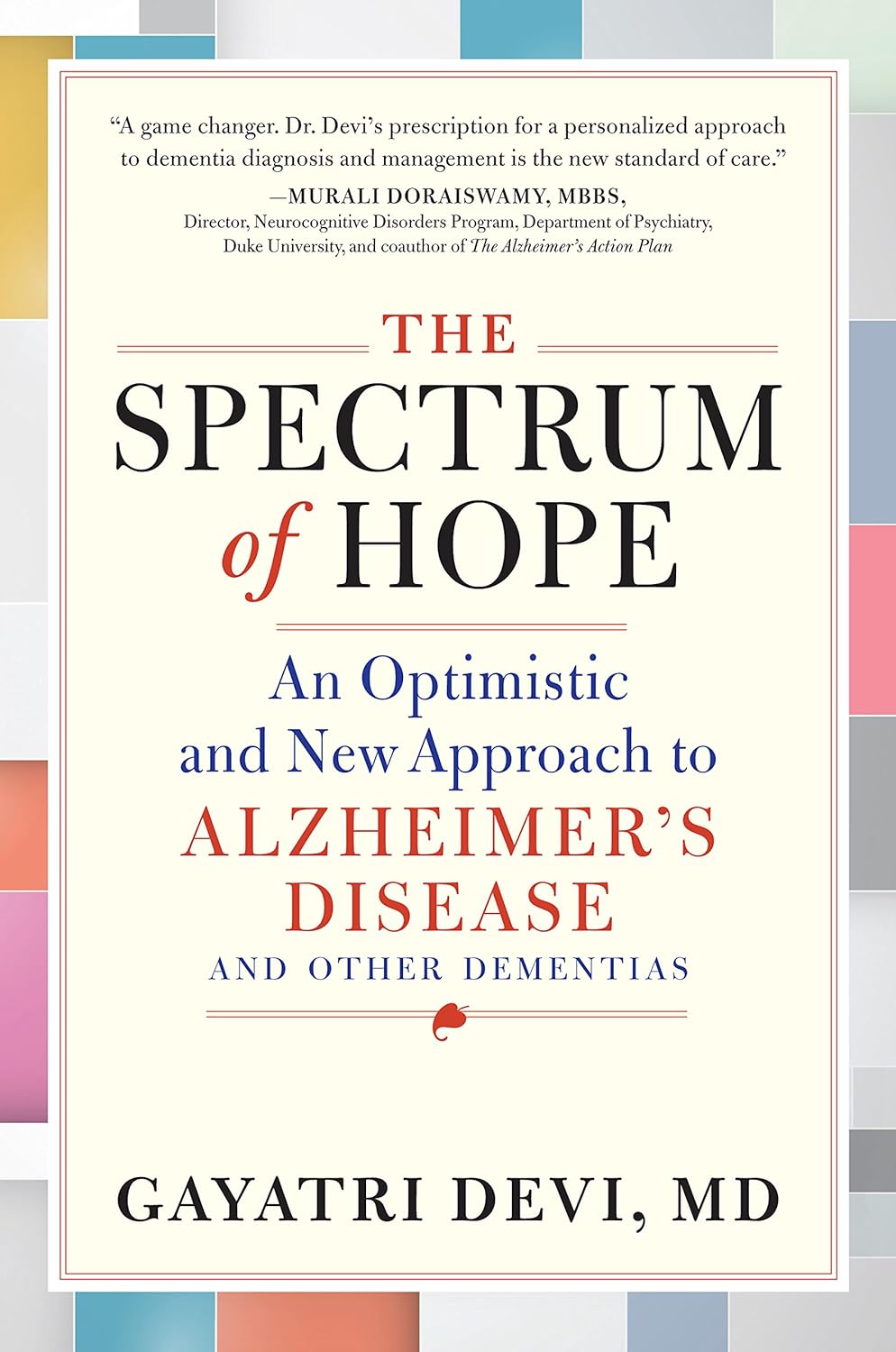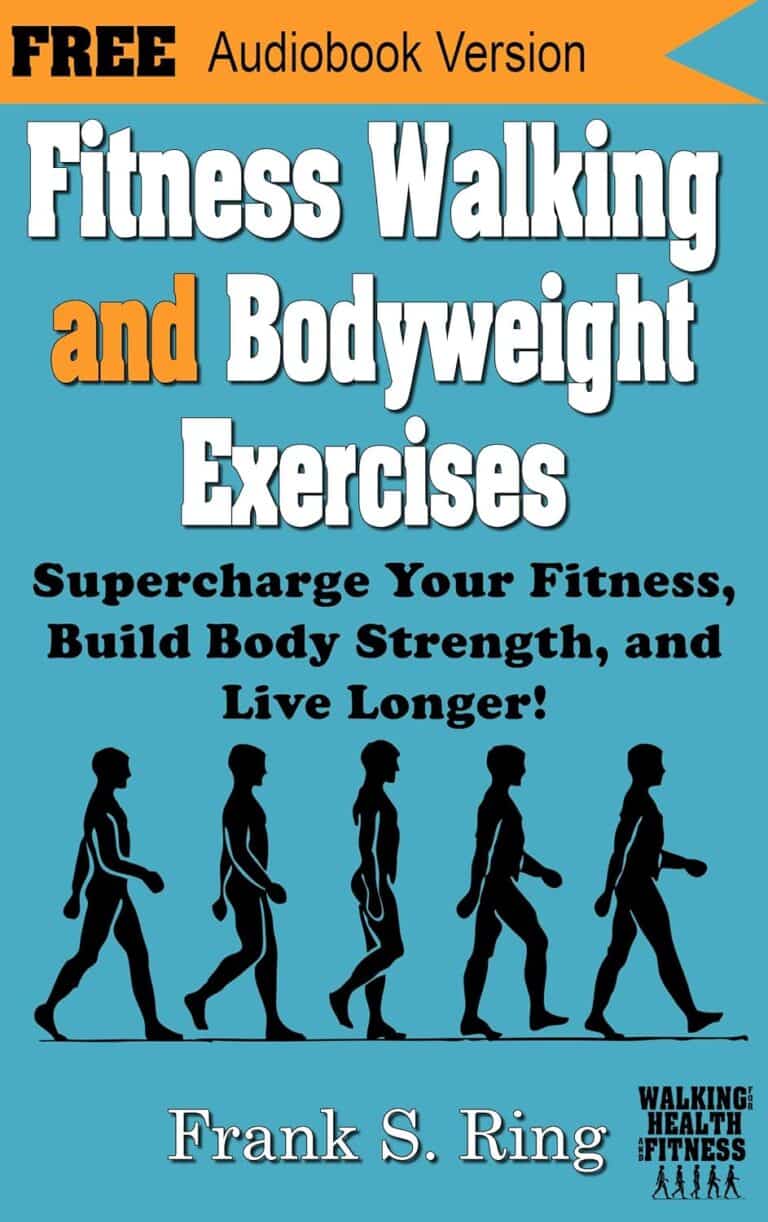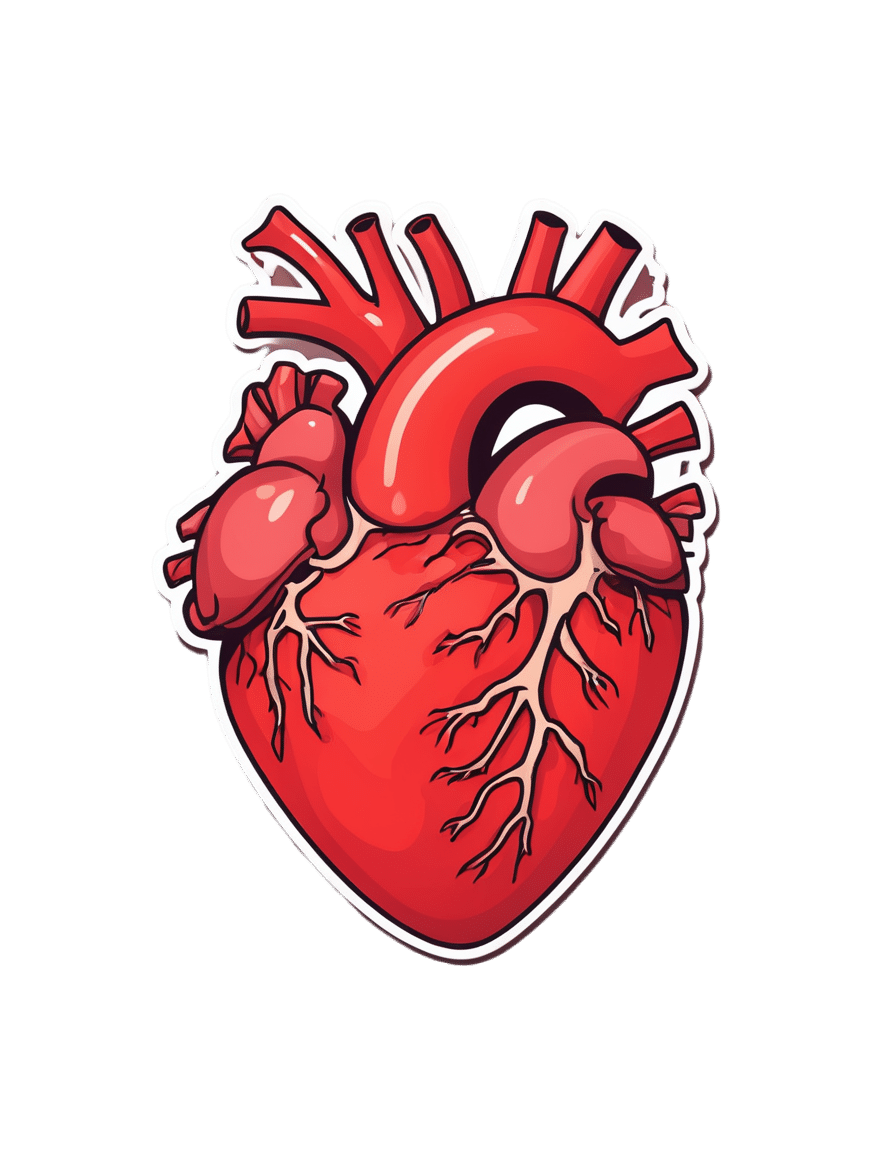
The Spectrum of Hope – by Dr. Gayatri Devi
10almonds is reader-supported. We may, at no cost to you, receive a portion of sales if you purchase a product through a link in this article.
We’ve written before about Dr. Devi’s work (See: “Alzheimer’s: The Bad News And The Good“) but she has plenty more to say than we could fit in an article.
The book is written for patients, family/carers, and clinicians—without getting deep into the science, which it is assumed clinicians will know. the general style of the book is pop-science, and it’s more about addressing the misconceptions around Alzheimer’s, rather than focusing on neurological features such as beta amyloid plaques and tau proteins and the like.
Dr. Devi explains a lot about the experience of Alzheimer’s—what to expect, or rather, what to know about in advance. Because, as she explains, there are a lot of different manifestations of Alzheimer’s that are all lumped under the same umbrella.
This means that a person could have negligible memory but perfect language and reasoning skills, or the other way around, or some other combination of symptoms showing up or not.
Which means that any plan for managing one’s Alzheimer’s needs to be adaptable and personalized, which is something Dr. Devi talks us through, too.
Bottom line: if you are a loved one has Alzheimer’s, or you just like to be prepared, this is a great book to prepare anybody for just that.
Click here to check out The Spectrum of Hope, and hold onto that hope!
Don’t Forget…
Did you arrive here from our newsletter? Don’t forget to return to the email to continue learning!
Recommended
Learn to Age Gracefully
Join the 98k+ American women taking control of their health & aging with our 100% free (and fun!) daily emails:
-
Are You Making This Alcohol Mistake?
10almonds is reader-supported. We may, at no cost to you, receive a portion of sales if you purchase a product through a link in this article.
The famous “small glass of red per day” is, as is quite well-established now in science, but not so much in popular culture, known to be not a good idea.
What most people don’t know
Rethinking “One Drink a Day”:
- Outdated beliefs and flawed studies:
- The idea that “one drink a day is healthy” stems from flawed associative studies that included…
- unhealthy former heavy drinkers in the zero-drinks category, and
- healthy older individuals who continued light drinking due to good health, not because alcohol contributed to it, in the drinkers category
- In other words, they looked at former alcoholics whose health was ruined by drinking and said “aha, non-drinkers have bad health”, and looked at the survivors of survivorship bias and said “aha, light drinking is the key to good health”. Which of course is terrible science propped up by terrible abuse of statistics propped up by shoddy methodology.
- The idea that “one drink a day is healthy” stems from flawed associative studies that included…
- New research findings:
- A 2022 UK Biobank Study showed that even one drink a day leads to brain shrinkage, neuron death, and cognitive decline.
- Another study on CVD disproved the notion that light drinking benefits heart health once confounding variables were removed.
- There are plenty more, and at 10almonds we’ve done a main feature about it, but for now, you get the idea.
Some other things you should know:
Ethanol and acetaldehyde damage neurons responsible for impulse control, judgment, motor coordination, and memory formation, leading to cognitive decline. The feeling of being drunk results from the suppression and damage of these neurons. But while the drunk feeling wears off, the damage to neurons does not.
Alcohol causes cumulative DNA damage in neurons, accelerates brain aging, and prevents the formation of new neurons, similar to a slow, gradual stroke.
Broader Health Impacts of Alcohol
We’ve said it before, and we’ll say it again: alcohol is bad for pretty much everything.
Here are some examples mentioned in the video:
- Neurodegenerative diseases: heavy drinking increases the risk of Alzheimer’s, particularly in those genetically predisposed.
- Sleep disruption: alcohol reduces deep, restful sleep and hampers the brain’s natural detox process overnight, contributing to morning grogginess.
- Inflammation and immune suppression: alcohol increases inflammation, exacerbates autoimmune diseases (like psoriasis and arthritis), and weakens immune function.
- Cancer risk: alcohol is classified as a Group 1 carcinogen by the International Agency for Research on Cancer, linked to various cancers, especially breast cancer. Even light drinking increases breast cancer risk.
- Hormonal imbalances: in women, alcohol heightens PMS symptoms, reduces fertility, and increases testosterone. In men, it lowers sperm quality and disrupts hormones.
For more on all of these and more, enjoy:
Click Here If The Embedded Video Doesn’t Load Automatically!
Want to learn more?
You might also like to read:
- Can We Drink To Good Health? ← this is mostly about red wine and heart health
- How To Reduce Or Quit Alcohol ← this is about the more general reasons to quit, and how to do so
- What Happens To Your Body When You Stop Drinking Alcohol ← a realistic timeline of recovery
Take care!
Share This Post
- Outdated beliefs and flawed studies:
-
Pine Bark’s Next-Level Antioxidant Properties
10almonds is reader-supported. We may, at no cost to you, receive a portion of sales if you purchase a product through a link in this article.
Pine Bark’s Next-Level Antioxidant Properties
Pine bark extract has been used by the indigenous peoples of N. America for a very long time, to treat a variety of ailments.
This one falls into the category of “things from traditional medicine that eventually got investigated and their scientific worth noticed by people from outside of those cultures”.
Not all pine trees!
If you happen to have pine trees near you, be aware that without sufficient botanical knowledge, you could find yourself bark-harvesting from the wrong tree—but many species of pine do have these qualities.
Useful (for this purpose) pine trees include, but are not limited to:
- Pinus banksiana
- Pinus massoniana
- Pinus pinaster
- Pinus radiata
- Pinus resinosa
- Pinus strobus
…which is already a fair list, but there are dozens more that have not been studied, and/or found lacking in medicinal qualities, and/or just didn’t make our list here today.
What does it do & How does it work?
We sneakily put those two questions together today because it’s easiest to explain in one:
The Pinus family in general has powerful antioxidant qualities, and not just like blueberries or coffee (wonderful as those are).
Rather, it has:
- Phenolic acids: these are the polyphenols found in many plant foods rich in antioxidants. These are great, but they aren’t the exciting part here.
- Catechins: these aren’t classified as antioxidants, but they are flavonoids that do the same job in a slightly different way
- Procyanidins: another class of flavonoids, and this is where pine bark really comes into its own
And yes, as ever, “those three things that always seem to come together”, it having these antioxidant properties means it is also anti-inflammatory and anti-cancer:
…and anti-aging:
Pleiotropic Effects of French Maritime Pine Bark Extract to Promote Healthy Aging
…which does of course mean that it almost certainly fights age-related cognitive decline, though studies for that have been animal studies so far, such as:
- Pine Bark Polyphenolic Extract Attenuates Amyloid-β and Tau Misfolding in a Model System of Alzheimer’s Disease Neuropathology
- Neuroprotective and Anti-Inflammatory Effects of Pinus densiflora Bark Extract in Gerbil Hippocampus Following Transient Forebrain Ischemia
- Neuroprotective Effects of Korean Red Pine ( Pinus densiflora) Bark Extract and Its Phenolics
- Pine bark treatment decelerates plaque development and improves spatial memory in Alzheimer’s disease mice
Where to get it?
As ever, we don’t sell it, but here’s an example product on Amazon for your convenience; we recommend shopping around though, as prices vary a lot!
Enjoy!
Share This Post
-
Heart Attack: His & Hers (Be Prepared!)
10almonds is reader-supported. We may, at no cost to you, receive a portion of sales if you purchase a product through a link in this article.
Heart attack symptoms vary by sex. This is governed by hormones, so if you are for example a postmenopausal woman and not on HRT, your symptoms might be nearer that of men.
The following symptom list is intended as a rough “most likely” guide. You may not get all of the symptoms you “should”. You could get symptoms from the “wrong” category. So don’t sweat the minutiae, but do be aware of…
Symptoms for everyone:
- Jaw, neck, and/or back pain
- Nausea and/or vomiting
- Shortness of breath
- Feeling of impending doom ← heart attack survivors assure us that you’ll know this one if you experience it
Additional symptoms (mostly) just for men:
- Pressure and/or pain in the upper chest
- Discomfort and/or tingling in the arms
- Sudden cold sweat
Additional symptoms (mostly) just for women:
- Pressure and/or pain in the lower chest and/or abdomen
- Feeling of fullness and/or indigestion
- Fatigue, dizziness, possibly fainting
In the event of experiencing symptoms…
Call 911 or your local equivalent.This is not the time to wait to see if it goes away by itself. If unsure, call. Better safe than sorry/dead.
If you are not alone, or if it is someone with you who is having the suspected heart attack, it may be quicker to go to the Emergency Room by car, than wait for an ambulance.
Even if you choose to do that, you should still call 911 anyway, as the responder will be able to instruct you in real-time, not something we can do in a newsletter.
Note that if available, this means three people in the car is ideal:
Driver, patient, and third person on the phone giving information and following instructions.
Emergency situations rarely go entirely by-the-book, but with a little foreknowledge and at least one person with a calm head, preventable deaths can be avoided.
Share This Post
Related Posts
-
Hydroxyapatite Toothpaste – 6 Month Update
10almonds is reader-supported. We may, at no cost to you, receive a portion of sales if you purchase a product through a link in this article.
A dental hygienist tried hydroxyapatite toothpaste for 6 months, and this is what she found:
The results are in
In few words: she took before-and-after photos, or rather, regular photos through the 6-month process.
What she was mostly looking for: tooth translucency, enamel imperfections, and stains.
What she found: a slight improvement within two months, though over the course of the six months, the photos were somewhat inconsistent—however, this may have more to do with the machinations of her camera, the ambient lighting, etc, than it has to do with the toothpaste. In an ideal world, she’d be able to do a density test with a laser on one side and a sensor on the other, but it seems her budget didn’t stretch to that. In terms of subjective improvement, she found that her teeth felt better, even if the visual change was not consistently apparent.
This is consistent with the idea that hydroxyapatite toothpaste can mineralize teeth throughout the tooth, not just from the outside in, due to the porous nature of the enamel. So, a lot of the change may have been on the inside.
Ultimately, she neither recommends nor discommends the toothpaste, and acknowledges that more time, up to a year, may be needed for more noticeable results.
For more on all of this plus visual demonstrations, enjoy:
Click Here If The Embedded Video Doesn’t Load Automatically!
Want to learn more?
You might also like:
Tooth Remineralization: How To Heal Your Teeth Naturally
Take care!
Don’t Forget…
Did you arrive here from our newsletter? Don’t forget to return to the email to continue learning!
Learn to Age Gracefully
Join the 98k+ American women taking control of their health & aging with our 100% free (and fun!) daily emails:
-
A New Tool For Bone Regeneration
10almonds is reader-supported. We may, at no cost to you, receive a portion of sales if you purchase a product through a link in this article.
When it comes to rebuilding bones, one of the tools in the orthopedic surgeon’s toolbox is bone grafts. This involves, to oversimplify it a bit, gluing particles of bone to where bone needs rebuilding. However, this comes with problems, most notably:
- that the bone tissue and the adhesive “glue” need to be prepared separately and mixed in situ, which is fiddly, to say the least
- that the resultant mixture mixed in situ will usually be unevenly mixed, resulting in weak bonding and degradation over time
- having any more of one part or the other in any given site means that bone regeneration and adhesion become a “pick one” matter, when both are critically needed
You may be wondering: why can’t they mix them before putting them in?
And the answer is: because then either the glue will set the bone prematurely (and now we have a clump of bone outside of the body which is not what we wanted), or else the glue will have issues with setting in situ, and now we have bone tissue running down the inside of someone’s leg and setting somewhere else, which is also not what we want.
These kinds of problems may seem a little more “arts and crafts” than “orthopedic surgery”, but they are the kind of nitty-gritty real-life real challenges that actually get in the way of healing patients’ bones.
The new solution
Biomaterial research scientists have developed an injectable hydrogel (containing all the necessary ingredients* that uses light to achieve cross-linking of bone particles and mineralization without any of the above being necessary. In again oversimplified terms: they inject the hydrogel where it’s needed, and then irradiate the site with harmless visible light which instantly sets it in place. As to how the light gets in there: it’s just very shiny, like candling an egg to see inside, or like how you can still approximately see bright light even with your eyes closed.
*alginate (natural polysaccharide derived from brown algae), RGD peptide-containing mussel** adhesive protein, calcium ions, phosphonodiols, and a photoinitiator.
**unclear whether this would trigger a shellfish allergy. Probably kosher per “פיקוח נפש” and Talmud Yoma 85b, but we are a health science newsletter, not Talmudic scholars, so please talk to your Rabbi. Probably halal per Qur’an 5:4 and failing that, the same principle as previously mentioned, expressed in Qur’an 5:3 and 6:119, but once again, your humble writer here is no Mufti, so please talk to your Imam. As for if you are vegetarian or vegan, then that is for you to decide whether to take a “medications with animal ingredients are unfortunate but necessary” stance, as most do. This vegan writer would (she’d grumble about it, though, and at least try to find an acceptable alternative first).
Back to the more general practicalities…
How it works, in less oversimplified terms:
❝The coacervate-based formulation, which is immiscible in water, ensures that the hydrogel retains its shape and position after injection into the body. Upon visible light irradiation, cross-linking occurs, and amorphous calcium phosphate, which functions as a bone graft material, is simultaneously formed. This eliminates the need for separate bone grafts or adhesives, enabling the hydrogel to provide both bone regeneration and adhesion.❞
“That’s great, but I was hoping for something I can do right now, ideally at home”
If getting glued back together was not on your bucket list, that’s understandable. There’s still a lot you can do for bone density; here’s a quick overview:
- Get it checked. Yes, this first, if you haven’t already! You want a basis for comparison later. Book a bone density scan. See for example this case study with bone density scans at each end: 21% Stronger Bones in a Year at 62? Yes, It’s Possible (No Calcium Supplements Needed!)
- Enjoy a diet rich in calcium and vitamin D yes, but be aware that you can have too much of a good thing, and doing so will result in more harm than good, including (paradoxically) for your bones. See: Vitamin D + Calcium: Too Much Of A Good Thing?
- Enjoy a diet rich is phosphorus, potassium, and magnesium, which things are also necessary for bone health, and in which people are much more likely to be deficient (especially magnesium). If you’re going to supplement, then there are very big difference in the efficacy of different kinds of magnesium supplement (brace yourself; the cheapest and most common kind barely does anything at all). See: Which Magnesium? (And: When?)
- Enjoy a diet rich in high quality protein—collagen is very useful, but if you want a plant-based approach, don’t worry, our body can and will make it for yourself if you give it a hand—and vitamin C to help its absorption, as well as glycine if you’re going the no-animals route. See: Collagen For Bones: We Are Such Stuff As Fish Are Made Of and: The Sweet Truth About Glycine: Making Your Collagen Work Better
- Consider medication, if your bone density is already lower than what it should be. There are meds to stop further deterioration, and different meds to encourage your body to rebuild bone. However, there are downsides to each of them: Which Osteoporosis Medication, If Any, Is Right For You?
- While we’re on the topic of medications, consider bioidentical HRT if you are female and not otherwise producing your own estrogen and progesterone in adequate quantities to maintain your skeletal integrity: HRT: A Tale Of Two Approaches
- Look after your gut too! So much starts there: Is Your Gut Leading You Into Osteoporosis? Bacterioides Vulgatus & Bone Health
- Lastly, exercise, but exercise right, because with insufficient resistance exercise your bones will not “think” they need to remain strong, and with the wrong kind of resistance exercise, you could break/compress your bones if they are already weak, so check out: Osteoporosis & Exercises: Which To Do (And Which To Avoid)
Too much information?
If that was too much information all at once, then we recommend this as your one-stop article:
The Bare-Bones Truth About Osteoporosis
Want more information?
We are but a humble newsletter and can only include so much per day, but we highly recommend this book we reviewed a little while back, which goes into everything in a lot more detail than we can here:
Enjoy!
Don’t Forget…
Did you arrive here from our newsletter? Don’t forget to return to the email to continue learning!
Learn to Age Gracefully
Join the 98k+ American women taking control of their health & aging with our 100% free (and fun!) daily emails:
-
The Power of Fun – by Catherine Price
10almonds is reader-supported. We may, at no cost to you, receive a portion of sales if you purchase a product through a link in this article.
It’s said that nobody’s dying regret is to wish they’d spent more time at the office, yet many of don’t make enough time for fun.
This book has been published with two different subtitles:
- Why fun is the key to a happy and healthy life
- How to feel alive again
One offers a sensible reason to read this book; the other offers a deeply emotional reason. Both are entirely valid.
Catherine Price sets out in this work to identify what fun actually is (she puts it at the intersection of playfulness, connection and flow) and how to have more of it (she gives a five-step method to build and integrate it into life).
In the category of criticism, this 334-page book is (in this reviewer’s opinion) a little padded and could have been an article instead. But the advice contained within it is sound, and the impact it can have might be profound.
Bottom line: if you find you’ve settled into a routine that’s perhaps comfortable, but not actually that much fun, this book will help you to liven things up.
Click here to check out The Power Of Fun, and feel more alive!
Don’t Forget…
Did you arrive here from our newsletter? Don’t forget to return to the email to continue learning!
Learn to Age Gracefully
Join the 98k+ American women taking control of their health & aging with our 100% free (and fun!) daily emails:







